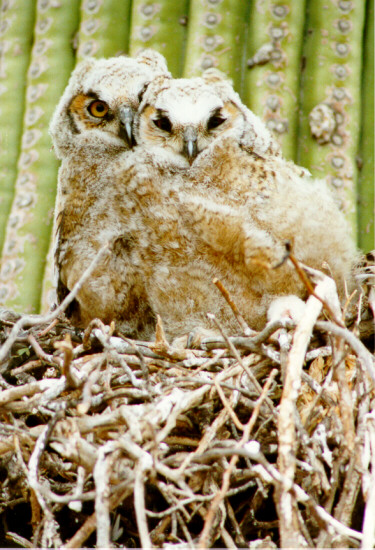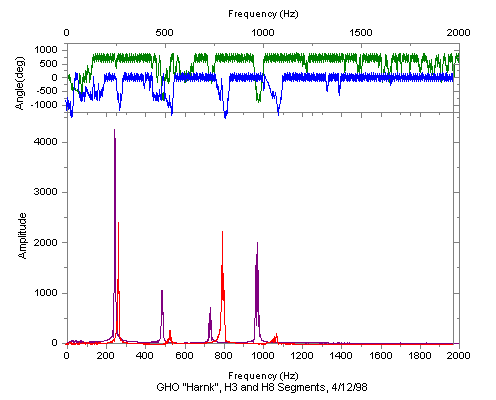Great-horned Owl Nest, Nestling Photographs, Sound Recording and FFT Analysis
Photo by Greg Clark, May 1998
 The Great-horned Owl is one of the world's most successful predators. It can be found in nearly all habitats in North America from the extreme north to the hottest deserts, including cities. In the sonoran desert both Red-tail Hawks and Great-horned Owls nest in saguaro cactus. The Great-horned Owl will typically stake out an old Red-tail Hawk nest early in the breeding season (like January or February) and by May the baby birds look like the ones in the photograph and are almost ready to leave the nest and begin spending their days on the ground and in the trees and saguaro. In 1997, near the US-Mexico border, we were awakened early in the morning by a faint call we have only heard a total of three times in the last 4 years. (The other locations were the Prescott National Forest south of Seligman, AZ, and the Apache-Sitgreaves National Forest near Heber, AZ.) Unlike the other times we had heard it, this time we had our best recording equipment ready and were able to record the rarely-heard "harnk" call of the Great-horned Owl (GHO). We knew it was a GHO because Tim had tracked the source of the call to a female GHO in the Prescott National Forest. Six minutes of recording has been shrunk to 30 seconds to shorten the download time and to make comparison of the individual "harnks" easier. This recording was made April 12, 1998 at 4:41 AM and is the earliest calendar date for the call. The other examples were heard in late May and mid-June. Because this overlaps the period when GHO chicks can be in the nest it is possible that this call is associated with the baby birds. If you listen carefully to the recording you can discern variations between the song segments. To see if these variations followed a pattern, all 16 groups were plotted using a mathematical technique called the Fast Fourier Transform (FFT). This technique reveals the frequency content of sounds, and the amplitude associated with each frequency. By comparing all the plots it was apparent that there were two basic frequency patterns. All of the segments fell into one or the other FFT plot types. An example of each FFT plot type has been plotted on the same graph to show how they are alike and different at the same time.
The Great-horned Owl is one of the world's most successful predators. It can be found in nearly all habitats in North America from the extreme north to the hottest deserts, including cities. In the sonoran desert both Red-tail Hawks and Great-horned Owls nest in saguaro cactus. The Great-horned Owl will typically stake out an old Red-tail Hawk nest early in the breeding season (like January or February) and by May the baby birds look like the ones in the photograph and are almost ready to leave the nest and begin spending their days on the ground and in the trees and saguaro. In 1997, near the US-Mexico border, we were awakened early in the morning by a faint call we have only heard a total of three times in the last 4 years. (The other locations were the Prescott National Forest south of Seligman, AZ, and the Apache-Sitgreaves National Forest near Heber, AZ.) Unlike the other times we had heard it, this time we had our best recording equipment ready and were able to record the rarely-heard "harnk" call of the Great-horned Owl (GHO). We knew it was a GHO because Tim had tracked the source of the call to a female GHO in the Prescott National Forest. Six minutes of recording has been shrunk to 30 seconds to shorten the download time and to make comparison of the individual "harnks" easier. This recording was made April 12, 1998 at 4:41 AM and is the earliest calendar date for the call. The other examples were heard in late May and mid-June. Because this overlaps the period when GHO chicks can be in the nest it is possible that this call is associated with the baby birds. If you listen carefully to the recording you can discern variations between the song segments. To see if these variations followed a pattern, all 16 groups were plotted using a mathematical technique called the Fast Fourier Transform (FFT). This technique reveals the frequency content of sounds, and the amplitude associated with each frequency. By comparing all the plots it was apparent that there were two basic frequency patterns. All of the segments fell into one or the other FFT plot types. An example of each FFT plot type has been plotted on the same graph to show how they are alike and different at the same time. 
The important parts of the graph are the comparisons between the red and violet curves that show frequency along the X axes (bottom) and amplitude along the Y (vertical) axes. The violet line represents the 3rd "harnk" in the recording and the red line represents the 8th "harnk". Note that both examples share a common frequency near 250Hz. However, at higher frequencies the red curve is consistently shifted higher in frequency. As you listen to the recording you will be able to hear that segment 8 sounds higher-pitched than segment 3. This also occurs between segments 15 and 16 and is easier to detect because they are next to each other. Aside from the question about what this odd, haunting, call is used for by the GHO, it is possible to surmise that either one owl can make two variations of the call, or there were two owls using the same call. GHOs call back and forth with their typical "who" call, so why not with this call also? This seems more likely, but we have no direct observations to support it. The next question we would like to answer is how do GHO react to playback of this recording? Do they respond at all to this call? Do they only respond at certain times of year? Do they recognize a particular "harnk" and only respond to that? If the call is not associated with territory then the birds may not care about this call at all. On the other hand, maybe the call is associated with young and the adult birds would investigate or return the call. There is a GHO near you right now, perhaps you can help us shed some light on this question.
On May 16, 1999, in South-Central Arizona, the "harnk" call was heard again. This time it was in response to a calling male GHO doing the classic "who's awake - me too" call. The male would call first and the female would answer. This very common species has a call that is not well understood yet. Imagine all the stuff we don't yet know about species that are harder to observe.
The original Great-horned Owl "harnk" sound recording was produced using a Sennheiser MKH70 shotgun microphone and the audio was stored on a 48 ksps DAT using a Tascam DA-P1 digital audio recorder. The recording was down-sampled to 44.1 ksps and converted to MPEG3 to reduce the file size to 417k bytes. The distance to the bird is unknown because it was at night and the source was not visible. However, the sound was weak and believed to be hundreds of feet away. Unfortunately, there was a diesel water pump several miles away that was in line with the microphone. A filter was used to remove these very low frequencies to make the recording more pleasant to listen to. The pump noise did not overlap the frequency content of the owl call. Because the sound level of the original recording was very low, software was used to increase the amplitude without significantly affecting the frequency content.
download mpeg3 recording (ghoharnk.mp3)
Copyright Greg Clark, 1999
update 8/2012